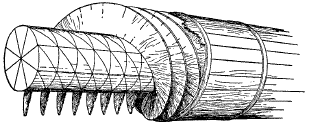Use the links below to share Rome, Sweet Rome: Ancient Lessons in Design on your favorite social networks.
Back to the Article >>
Rome, Sweet Rome: Ancient Lessons in Design
March 12th, 2008 in Design Inspiration
by: Matthew Griffin
When I arrived late to my first panel on Saturday morning at SXSWi 2008 I thought I had accidentally walked in on a reading for a book-on-tape. (lead user experience director at Corel) was the singular presenter, reading off her notes word for word in a timid voice that had the whole audience leaning forward and tilting an ear. I have to admit that Jennifer's departure from the typical in-your-face SXSWi panelist style felt a little alien at first but as I listened, I began to warm up to it. By the end of the panel, I was captivated. Fraser had very effectively taken the system of architectural design principles developed by Vitruvius in ancient Rome and applied them to modern interactive design.
Marcus Vitruvius Pollio was a brilliant Roman architect and engineer who lived in the last century BC. The influence of his work stretched to the renaissance in the form of Da Vinci's famous vitruvian man and his principles of architecture are still referenced today. In his only surviving work, De Architectura , Vitruvius posits three elementary principles of good architectural design—durability, convenience, and beauty.

In architecture, the concept of durability is most closely associated with the foundation of the structure. Of course, it's always important to build on foundations that will last and use materials that are durable. But, as Fraser explained, in in website design we are given foundations that are anything but durable and consistent. Our work must be rendered on multiple browsers in multiple operating systems all presenting their own set of quirks. This shaky foundation leaves the web designer with no option but to fail gracefully. An example of this was made out of FireFox's new "restore session" feature. In case you've never used it (I can't imagine anyone reading this hasn't), it prompts you to restore the various windows and tabs you had open in the event of an unexpected shutdown. Mozilla realized that sometimes, their browser will crash. Instead of throwing their hands up, they provided a way to fail gracefully.
Convenience was next on the list. Vitruvius' definition of convenience had to do with appropriately placing rooms in a house. First, laying them them out in an organization that made sense for the purpose of the house. Then making clear distinction between common and private rooms. Jennifer transfers the first definition of convenience to interactive design in terms of usability. In Vitruvius' words, "Perfection of style that arises out of adherence to authoritative principles." In web design we educate ourselves in these authoritative principles every time we read an article on A List Apart or pick up a book on UX. The second part of convenience is discussed in terms of ethics in pulling and pushing data to and from the end user. We should always knock loudly before entering a private room of one of our visitors.
Beauty was the last principle discussed. Vitrivius understood beauty as fitness in the adjustments of the members of a structure. I think Jennifer perfectly encapsulated this concept in a quote from Vitrvius. "...the eye is always in search of beauty, and if we do not gratify its desire for pleasure by proportionate enlargement in these measures... a clumsy and awkward appearance will be presented to the beholder."
I'm interested in developing these concepts further. Fraser's last diagram in her presentation was a fascinating attempt at building an objective metric by which to measure the effectiveness of a design. This type of approach is virtually unheard of in the modern climate of relativism, and it brings up some interesting ideas related to applying a Christian worldview to design.
Update 3/17/08: Jennifer Fraser was kind enough to drop by Bits O' NewMedia and post a link to her presentation. If you are interested in seeing the original, .
- 8 Comments
- 2458 Views